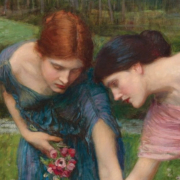Roses and Ashes
Gather ye Rose-buds while ye may,
Old Time is still a-flying:
And this same flower that smiles today,
Tomorrow will be dying.
Robert Herrick, “To the Virgins, to Make Much of Time” 1648
In a rare, but not unprecedented, synchronicity this month, St. Valentine’s Day and Ash Wednesday will fall on the same day. These two dates last came together in 2018, and they will do it again in 2029. According to the Fayetteville Observer, this convergence seems to happen approximately three times in every one-hundred-years. The Twentieth Century also recorded three occurrences, in 1923, 1934, and 1945. (1)
The origins of our contemporary St. Valentine’s Day celebration are hidden in history. Even Roman Catholic sources record an astounding variety, of what can perhaps best be regarded as legends. He may have been a priest, a bishop, and/or a physician. It’s unclear whether the stories that have been combined under this saint’s name include the life one man, or the lives of two.
There is some evidence that, on an actual occasion, a prisoner named Valentine left a letter for his jailer’s daughter signed, “from your Valentine.” He’s said to have healed the child of her blindness; we all prefer to believe he did. He may well have converted her to Christianity. He might have converted her father, too. Plausible evidence does exist that a man named Valentine was imprisoned and martyred for his Christian faith. Other tales suggest that the little girl, and possibly her father, died with him. (2)
One fact is clear, that the official liturgical calendar of the United States makes no reference to a saint’s feast on February 14. On the USCCB website, it’s marked only with a purple dot indicating a day of Lent. There is no alternate reading for a saint’s feast day. (3)
Another mystery is how a saint, whom most legends report died as a martyr for his Faith, came to be a symbol of chocolate, flowers, and every other sort of indulgent romantic concupiscence.
Ash Wednesday, on the other hand, is a reminder of the death we all will experience. The Latin counsel memento mori, “remember you will die,” dates back to the ancient Greek philosopher Socrates, from sometime before his death in 399 B.C. (4).
The use of ashes as a symbol of penance and anointing for death by the Hebrews is documented in the Old Testament books of Esther 4:1, 484-465 B.C.; Job 42:6, 700-500 B.C.; Daniel 9:3, circa 550 B.C.; and Jonah 3:5-6, circa 500 B.C. (5)

Eleanor Fortescue-Brickdale, Illustration from The Book of Old English Songs and Ballads, Circa 1920; Public
domain, via Wikimedia Commons
A solemn recognition of Ash Wednesday has been practiced since the earliest days of Christianity. The words, “For you are dust, and to dust you shall return,” from Genesis 3:19 (6), have been spoken through millennia in both the Eastern and Roman Catholic churches. They are still used for Ash Wednesday services in many Protestant churches today, as well.
But the question remains. What meaning can we discern from this mysterious union of love with death, that seems to appear as a trinity in multiple centuries?
For one answer, we might turn again to scripture, and discover that Song of Songs is the only one of three writings classified by biblical scholars as ‘Wisdom books’ that appears in Protestant bibles. Our Catholic Bibles contain all three, with the Book of Wisdom and the Book of Sirach included (7). Here is another trinity.
The Song, also called Canticle of Canticles, is a romantic poem that evokes all the sensual joys of earthly lovers, as metaphors that describe God’s desirous love for us. In Christian churches it is read as allegory (8). The determination of the bride to reach her lover, and the strength of their bond, represent the Sacrament of Matrimony on earth and Christ’s love for His Bride, the Church, in eternity.
When the cross of ashes, death, and dust is marked on our foreheads again this year — and the day wavers from joy, to penance, and grief — may we remember the powerful lover who awaits us, and continue to sing the Canticle:
“… Set me as a seal upon your heart,
as a seal upon your arm;
For Love is strong as Death …
Deep waters cannot quench love,
nor rivers sweep it away …
… You who dwell in the gardens,
my companions are listening for your voice–
let me hear it!
Swiftly, my lover,
be like a gazelle or a young stag
upon the mountain of spices.”
Song (Cant.) 8:6-7, 13-14 (9)

John William Waterhouse, Gather Ye Rosebuds While Ye May; 1909, Public domain, via Wikimedia
Commons.
© Copyright 2024 by Margaret King Zacharias
Featured Photo: John William Waterhouse, Gather Ye Rosebuds While Ye May,1908, Public domain, via
Wikimedia Commons.
Footnotes for Roses and Ashes and Sources for Further Reading
-
For a few different perspectives, see:
https://www.catholic.com/magazine/online-edition/will-the-real-st-valentine-please-stand-up
https://www.britannica.com/biography/Saint-Valentine
https://www.catholiceducation.org/en/culture/catholic-contributions/history-of-st-valentine.html
-
https://bible.usccb.org/bible/readings/021424.cfm
-
https://dailystoic.com/what-is-memento-mori/#:~:text=Memento%20Mori%20—%20(Latin%3A%20remember,but%20dying%20and%20being%20dead.”


